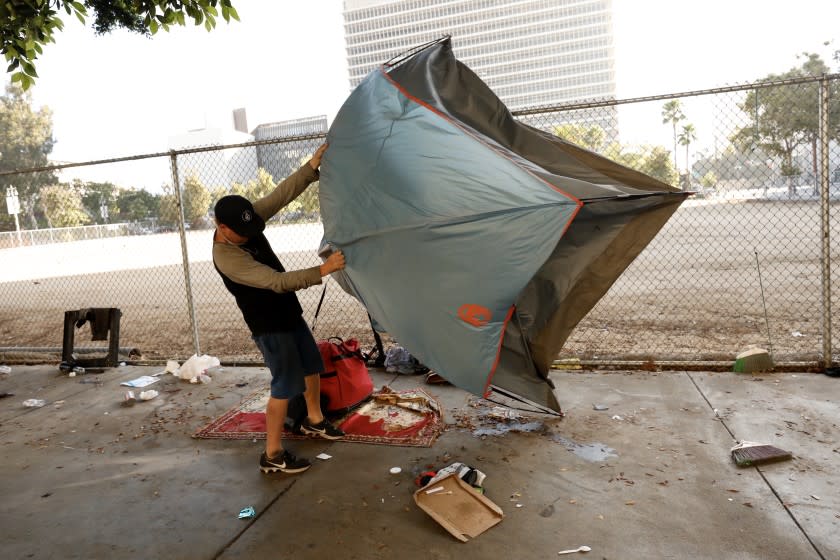Editorial: Not even beach parking lots can be off-limits in a study of sites for temporary homeless housing

Among the many obstacles to providing shelter and housing for homeless people is finding available land. Private property is often too expensive for the city of Los Angeles to buy for housing, so there is a constant search by city officials to locate publicly owned land that is empty or underutilized and can be transformed into safe camping grounds, tiny-house villages or more permanent housing.
Recently, Councilman Mike Bonin proposed to study the feasibility of several locations for tiny homes or safe camping (and, in one case, safe parking) for homeless people. Bonin wants to consider county-owned parking lots at two beaches in his Westside district — Will Rogers State Beach and Dockweiler Beach — and another at a boat-launch ramp in nearby Marina Del Rey. He is also looking at an empty lot — which the owner is willing to let the city use temporarily, and where homeless people have an encampment — near Ballona Creek. And he wants to consider using portions of Westchester and Mar Vista parks where homeless people are currently camped.
But the mere idea of evaluating these sites has drawn vocal opposition from several Westside neighborhood and community councils, as well as an online petition signed by more than 20,000 critics. Another online petition, signed by more than 12,000 people, urges that Bonin be recalled. The executive committee of the Pacific Palisades Community Council, which represents the area by Will Rogers State Beach, wrote in a letter to city and county officials, “We reject in the strongest possible terms the proposition that an ‘immediate emergency’ exists.”
Well, homelessness is an immediate emergency. Isn’t that what most city residents (except the ones in the Palisades, apparently) keep saying to anyone who will listen? And Bonin is an example of a councilmember acting on that. Enterprising and, frankly, brave in the face of ferocious community opposition, he has championed numerous permanent supportive-housing projects, a bridge shelter and two Project Homekey hotels in his district. He also is trying to set up a shelter for homeless women in a portion of his West L.A. office building. But as Bonin himself says, more is needed urgently.
This proposal is not about allowing tents on beaches. The study would explore the feasibility of putting a sanctioned campsite or a tiny-home village in a beach parking lot, where there would be security, restrooms, food and water, and service providers to help people get to the next level of housing. It’s possible that putting camps even in parking lots will pose too many problems. Will it interfere with beachgoers trying to park? Will the Coastal Commission approve? Those are legitimate questions. So let a study examine all that.
The question is not why Bonin came up with this proposal but why the other councilmembers haven’t done similar things in their districts. Yes, a number of councilmembers have found and are using public properties for temporary homeless housing. But as Councilmember Mark Ridley-Thomas, who chairs the council's Homelessness and Poverty Committee, said in support of Bonin’s proposal, “We should leave no stone unturned. ... It doesn’t mean all these things will come to fruition but it does mean due diligence should be the order of the day.” The rest of the council should heed his words and approve Bonin's proposal when it comes up for a vote.
City Controller Ron Galperin has published a map that shows the nearly 14,000 government-owned properties in Los Angeles, about 7,500 of which belong to the city. But the map does not distinguish between underutilized and fully utilized properties. (For example, the Greek Theater is one of them.) The city controller’s office should work to identify which properties are available for use.
Homelessness is the moral crisis of our time in the city. And before you say, "It’s not my problem," it is your problem. Homeowners need to remember that the market forces that have escalated their property values at warp speed are the same forces that have left the poorest of the poor tumbling out of housing. Homeless people don’t have to move under your roof. But stop resisting them moving into a safe space near you or your favorite haunts.
This story originally appeared in Los Angeles Times.

